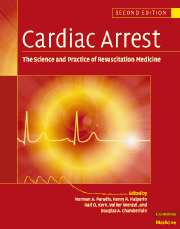Book contents
- Frontmatter
- Contents
- List of contributors
- Foreword
- Preface
- Part I Introduction
- 1 A history of cardiopulmonary resuscitation
- 2 The epidemiology of sudden death
- Part II Basic science
- Part III The pathophysiology of global ischemia and reperfusion
- Part IV Therapy of sudden death
- Part V Postresuscitation disease and its care
- Part VI Special resuscitation circumstances
- Part VII Special issues in resuscitation
- Index
1 - A history of cardiopulmonary resuscitation
from Part I - Introduction
Published online by Cambridge University Press: 06 January 2010
- Frontmatter
- Contents
- List of contributors
- Foreword
- Preface
- Part I Introduction
- 1 A history of cardiopulmonary resuscitation
- 2 The epidemiology of sudden death
- Part II Basic science
- Part III The pathophysiology of global ischemia and reperfusion
- Part IV Therapy of sudden death
- Part V Postresuscitation disease and its care
- Part VI Special resuscitation circumstances
- Part VII Special issues in resuscitation
- Index
Summary
For much of recorded history, humans have viewed death as irreversible. For religious and scientific reasons it was considered impossible, or even blasphemous, to attempt to reverse death. It was not until the latter part of the eighteenth century that humans began to believe that resuscitation was possible. Another 200 years passed before the skills for resuscitation were developed to a degree that made the reversibility of cardiac arrest a practical reality in the 1960s. Many important observations and much real progress had nevertheless been made during the intervening years. But the clinical problems were poorly understood, the implications of new discoveries were not always appreciated, single components of life-saving were attempted in isolation, procedures that were potentially effective were often displaced by those of no value, and suitable technology was lacking. Resuscitation had to await its time. Nevertheless, its history is of interest and has important lessons for us today.
The earliest years
The first written account of a resuscitation attempt is that of Elijah the prophet. The story in the Bible tells of a griefstricken mother who brought her lifeless child to Elijah and begged for help. Elijah stretched himself upon the child three times and, with the assistance of God, brought the child back to life. An even more detailed account of a resuscitation attempt is that of the prophet Elisha, a disciple of Elijah. The child of a Shunemite couple whom Elisha had befriended suffered from a severe headache. He cried out, “Oh, my head, my head!” and collapsed. Was this a subarachnoid bleed? The Bible gives no further clues. The boy died several hours later.
- Type
- Chapter
- Information
- Cardiac ArrestThe Science and Practice of Resuscitation Medicine, pp. 3 - 25Publisher: Cambridge University PressPrint publication year: 2007
- 3
- Cited by



